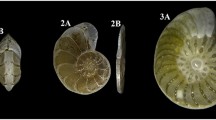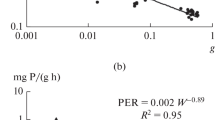Summary
Thirty-four species of marine macroalgae from around St. Andrews, Scotland, have been assayed for their external activity and thirty-three species for their total activity of carbonic anhydrase. Activity was detected in all the Rhodophyta tested apart from Chondrus crispus, but was absent in Codium fragile, Enteromorpha sp. and Monostroma fuscum (Chlorophyta), and Alaria esculenta, Laminaria digitata, L. saccharina and L. hyperborea (Phaeophyta). Total activity of carbonic anhydrase per unit fresh weight tended to be higher in the Rhodophyta than in the Chlorophyta or Phaeophyta. External activity was present in two of the six Chlorophyta, four of the twelve Phaeophyta and four of the sixteen Rhodophyta tested. On average, when present, external carbonic anhydrase activity represented 2.7% of the total activity. A relationship was found between total carbonic anhydrase activity and habitat. Species from the high intertidal and the low-light subtidal habitats had significantly higher activity than species from the mid and low intertidal, rockpools, or high-light region of the subtidal. External carbonic anhydrase activity did not vary significantly with habitat. There appeared to be no strong relationship between carbonic anhydrase activity and the ability of a species to use HCO 3- in photosynthesis under water.
Similar content being viewed by others
References
Atkins CA, Patterson BD, Graham D (1972) Plant carbonic anhydrase. I. Distribution of type among species. Plant Physiol 50:214–217
Bidwell RGS, McLachlan J (1985) Carbon nutrition of seaweeds: Photosynthesis, photorespiration and respiration. J Exp Mar Biol Ecol 86:15–46
Bowes GW (1969) Carbonic anhydrase in marine algae. Plant Physiol 44:726–732
Bowes GW (1985) Pathways of CO2 fixation by aquatic organisms. In: Lucas WJ, Berry SA (eds) Inorganic carbon uptake by aquatic photosynthetic organisms. The American Society of Plant Physiologists, Rockville, USA, pp 187–210
Coleman JR, Grossman AR (1984) The biosynthesis of carbonic anhydrase in Chlamydomonas reinhardtii during adaptation to low CO2. Proc Natl Acad Sci USA 81:6049–6053
Coleman JR, Green LS, Berry JA, Togasaki RK, Grossman AR (1985) Adaptation of Chlamydomonas reinhardtii to air levels of CO2 and the induction of carbonic anhydrase activity. In: Lucas WJ, Berry JA (eds) Inorganic carbon uptake by aquatic photosynthetic organisms. The American Society of Plant Physiologists, Rockville, USA, pp 339–359
Colman B, Cook CM (1985) Photosynthetic characteristics of the marine macrophytic red alga Rhodymenia palmata: evidence for bicarbonate transport. In: Lucas WJ, Berry JA (eds) Inorganic carbon uptake by aquatic photosynthetic organisms. The American Society of Plant Physiologists, Rockville, USA, pp 97–110
Cook CM, Lanaras T, Colman B (1986) Evidence for bicarbonate transport in species of red and brown macrophytic marine algae. J Exp Bot 37:977–984
Cook CM, Lanaras T, Roubelakis-Angelakis KA (1988) Bicarbonate transport and alkalization of the medium by four species of Rhodophyta. J Exp Bot 39:1185–1198
Dixon GK, Merrett MJ (1988) Bicarbonate utilization by the marine diatom Phaeodactylum tricornutum Bohlin. New Phytol 109:47–51
Graham D (1982) Carbonic anhydrases (carbonate dehydratases) from plants. In: CRC Handbook of biosolar resources I part 1. Basic Principles, edited by A. Mitsui and C.C. Black, CRC Press Inc Boch Raton, Florida: 215–229
Graham D, Smillie RM (1976) Carbonate dehydratase in marine organisms of the Great Barrier Reef. Aust J Plant Physiol 3:113–119
Hiscock S (1986) A field key to the British red seaweeds. Occasional Publication No. 13, Field Studies Council, Taunton
Ingle RK, Colman B (1975) Carbonic anhydrase levels in bluegreen algae. Can J Bot 53:2385–2387
Lindskog S, Henderson LE, Kannan KK, Liljas A, Nyman PO, Strandberg B (1971) Carbonic anhydrase. In: Boyer PD (ed) The enzymes V. Academic Press, New York, pp 587–665
Miller AG, Colman B (1980) Evidence for HCO 3- transport by the blue-green alga (cyanobacterium) Coccochloris peniocystis. Plant Physiol 65:397–402
Miyachi S, Tsuzuki M, Yagawa Y (1985) Carbonic anhydrase in various microalgae. In: Lucas WJ, Berry JA (eds) Inorganic carbon uptake by aquatic photosynthetic organisms. The American Society of Plant Physiologists, Rockville, USA, pp 145–154
Moroney JV, Husic HD, Tolbert NE (1985) Effect of carbonic anhydrase inhibitors on inorganic carbon accumulation by Chlamydomonas reinhardtii. Plant Physiol 79:177–183
Parke M, Dixon PS (1976) Check-list of British marine algae—third edition. J Mar Biol Ass UK 56:527–594
Poincelot RP (1979) Carbonic anhydrase. In: Gibbs M, Latzko E (eds) Encyclopedia of plant physiology, NS, 6. Springer, Berlin, Heidelberg, New York, pp 230–238
Price GD, Badter MR, Bassett ME, Whitecross MI (1985) Involvement of plasmalemmasomes and carbonic anhydrase in photosynthetic utilization or bicarbonate in Chara corallina. Aust J Plant Physiol 12:241–256
Reiskind JB, Seamon PT, Bowes G (1988) Alternative methods of photosynthetic carbon assimilation in marine macroalgae. Plant Physiol 87:686–692
Smith RG, Bidwell RGS (1987) Carbonic anhydrase-dependent inorganic carbon uptake by the red macroalgae, Chondrus crispus. Plant Physiol 83:735–738
Sokal RR, Rohlf FJ (1981) Biometry. WH Freeman and Co, San Francisco, California, second edition
Spalding MH, Spreitzer RJ, Ogren WL (1983) Carbonic anhydrase-deficient mutant of Chlamydomonas reinhardtii requires elevated carbon dioxide concentration for autotrophic growth. Plant Physiol 73:268–272
Spencer KG, Kimple DL, Fisher M, Togasaki RK, Miyachi S (1983) Carbonic anhydrase in Chlamydomonas reinhardtii II. Requirements for induction of carbonic anhydrase. Plant Cell Physiol 24:301–304
Surif MB, Raven JA (1989) Exogenous inorganic carbon sources for photosynthesis in seawater by members of the Fucales and Laminariales (Phaeophyta): ecological and taxonomic implications. Oecologia 78:97–105
Williams TG, Turpin DH (1987) The role of external carbonic anhydrase in inorganic carbon acquisition by Chlamydomonas reinhardtii. Plant Physiol 83:92–96
Author information
Authors and Affiliations
Rights and permissions
About this article
Cite this article
Giordano, M., Maberly, S.C. Distribution of carbonic anhydrase in British marine macroalgae. Oecologia 81, 534–539 (1989). https://doi.org/10.1007/BF00378965
Received:
Accepted:
Issue Date:
DOI: https://doi.org/10.1007/BF00378965




